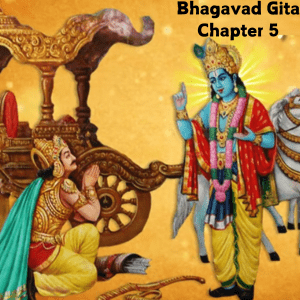Bhagavad Gita Chapter 5: Unveiling the Path of Action in Karma Sanyasa yoga

The Bhagavad Gita, a 700-verse Hindu scripture that is part of the Indian epic Mahabharata, is a conversation between prince Arjuna and the god Krishna, who serves as his charioteer. Bhagavad Gita Chapter 5, titled “The Yoga of Renunciation,” delves into the themes of action and renunciation, presenting a guide to living a life of balance and spiritual fulfillment. This chapter, with its 29 verses, provides profound insights into how one can achieve liberation through detached action and steadfast wisdom.
Bhagavad Gita Chapter 5: Verses
Setting the Stage (Verses 1-2):
Verse 1: The Inquisitive Arjuna
Arjuna starts Bhagavad Gita Chapter 5 by asking Krishna a crucial question. He is confused about whether renunciation (sannyasa) or the yoga of action (karma yoga) is superior. This question sets the stage for Krishna’s teachings on the balance between action and renunciation.
Verse 2: Krishna’s Initial Response
Krishna responds by emphasizing that both renunciation and the yoga of action can lead to liberation. However, He highlights that performing one’s duty without attachment (karma yoga) is superior because it is easier to practice and more effective in achieving spiritual progress.
Karma and Sacrifice: A Divine Dance (Verses 3-9):
Verse 3: The True Renouncer
Krishna defines a true renouncer as one who neither hates nor desires. Such a person is free from dualities and lives in a state of peace, constantly renouncing the fruits of their actions.
Verse 4: Path of Knowledge vs. Path of Action
Here, Krishna explains that both the path of knowledge (jnana yoga) and the path of action (karma yoga) lead to the same goal. He advises that understanding this unity is crucial for spiritual seekers.
Verse 5: Unity of Paths
Krishna further clarifies that the outcomes of both paths are the same because they both purify the mind and lead to liberation. He encourages Arjuna to recognize the equality of these paths.
Verse 6: Challenges of Renunciation
Krishna points out that renunciation is difficult to achieve without a disciplined mind. Those who try to renounce without self-discipline often fall back into worldly desires.
Verse 7: The Yogi’s Equanimity
A true yogi, according to Krishna, is one who is pure, self-controlled, and free from desires. Such a yogi sees all beings with an equal eye and remains unperturbed by external circumstances.
Verse 8-9: Detached Action
Krishna teaches that a wise person performs all actions with detachment, considering themselves merely an instrument of divine will. Whether eating, sleeping, or working, they remain unaffected by these actions.
Rising Above Duality: The Key to Liberation (Verses 10-15)
Verse 10: Offering Actions to God
Those who dedicate all their actions to God, without attachment to the results, are not tainted by sin, just as a lotus leaf remains untouched by water.
Verse 11: Purity in Action
Krishna advises performing actions with a pure mind and without selfish desires. This purity leads to liberation and inner peace.
Verse 12: Peace Through Renunciation
By renouncing the fruits of their actions, a person attains lasting peace. Conversely, those who are attached to the results of their actions experience anxiety and stress.
Verse 13: The Seated Soul
A liberated person, while living in the body, does not identify with it. They see themselves as distinct from their physical form and remain unaffected by bodily experiences.
Verse 14-15: God and Free Will
Krishna explains that God does not create actions or their results; these are born of human nature and free will. Ignorance clouds understanding, leading to attachment and suffering.
The Art of Skillful Action: Avoiding Attachment (Verses 16-22)
Verse 16: Destroying Ignorance
The light of knowledge destroys the darkness of ignorance. Those who gain this knowledge see the divine presence everywhere and in everything.
Verse 17: Steadfast Wisdom
Individuals who are steadfast in their knowledge, with their intellects firmly rooted in the divine, achieve liberation. They transcend the cycle of birth and death.
Verse 18: Vision of Equality
A wise person sees all beings as equal, whether a learned scholar, a cow, an elephant, a dog, or an outcast. This vision of equality is a hallmark of true wisdom.
Verse 19: Overcoming Dualities
By seeing the divine in all beings, one overcomes the dualities of life such as pleasure and pain, gain and loss. This transcendent vision brings liberation.
Verse 20: Unshaken Mind
Krishna advises maintaining a steady mind amidst success and failure. Such equanimity is essential for spiritual growth and inner peace.
Verse 21: Joy Within
True joy comes from within, not from external sources. A person who finds joy within is unaffected by the temporary pleasures and pains of the world.
Verse 22: Fleeting Pleasures
Material pleasures are temporary and ultimately lead to suffering. Krishna advises seeking lasting happiness through spiritual practice and self-realization.
The Yogi: A Beacon of Balance (Verses 23-26)
Verse 23: Conquering Desires
Control over one’s desires and anger leads to true happiness. By conquering these internal enemies, one achieves inner peace and liberation.
Verse 24: Inner Light
A person who is self-satisfied and self-controlled, with their mind focused on the divine, radiates inner light and remains in a state of bliss.
Verse 25: Freedom from Desires
Freedom from desires and attachments is essential for peace. Such a person lives a life of contentment and harmony, untouched by external turmoil.
Verse 26: The Peaceful Sage
Krishna describes the sage who has achieved peace through self-discipline and detachment. This sage is free from anger and desires, living in harmony with the world.
Transcending Action and Inaction (Verses 27-28)
Verse 27-28: Meditation and Control
Meditation and control over the senses are crucial practices for spiritual growth. By focusing the mind and controlling the breath, one attains a state of deep peace and connection with the divine.
Offering the Self: The Ultimate Sacrifice (Verse 29)
Verse 29: The Ultimate Refuge
Krishna concludes by inviting Arjuna to take refuge in Him, the ultimate source of peace and liberation. Surrendering to Krishna leads to eternal bliss and freedom from the cycle of birth and death.
Key Learnings from Bhagavad Gita Chapter 5 – Karmayoga
Bhagavad Gita Chapter 5 emphasizes the importance of performing one’s duty without attachment to the results. Ultimately, surrendering to the divine and finding joy within are central to the teachings of this chapter.
- Fulfilling One’s Duty: Karmayoga emphasizes the importance of performing our designated duties (swadharma) with dedication and skill.
- Equanimity: The Guiding Light: Cultivating equanimity allows us to navigate the ups and downs of life with a balanced mind.
- Detachment with Action: Karmayoga teaches us to perform actions without clinging to the results. This frees us from the cycle of desire and disappointment.
- Surrendering the Ego: The chapter promotes letting go of ego, recognizing ourselves as instruments in the hands of the divine.
- Living a Life of Purpose: By dedicating our actions to a higher purpose, we elevate our lives beyond mere self-interest.
Karmayoga in Our Daily Lives
The wisdom of Bhagavad Gita Chapter 5 – Karmayoga is universally applicable. Here’s how we can integrate it into our daily lives:
- Finding Purpose in Our Work: Approach your work with dedication, focusing on the process and the value you bring.
- Serving Others with Selflessness: Volunteer your time and skills to uplift others, without seeking recognition.
- Maintaining Inner Peace: Cultivate equanimity by accepting life’s challenges as opportunities for growth.
- Living with Gratitude: Be thankful for the opportunities to act and contribute to the world.
Conclusion
Bhagavad Gita Chapter 5 offers profound guidance on living a balanced and spiritually fulfilling life. By understanding and practicing the principles of detached action, inner discipline, and seeing the divine in all beings, one can achieve lasting peace and liberation. Krishna’s teachings provide a roadmap for transcending the dualities of life and finding true joy and contentment within.
Frequently Asked Questions
- What is the main message of Bhagavad Gita Chapter 5?
The main message is the importance of performing one’s duty without attachment and achieving inner peace through detached action and spiritual discipline.
- How does Krishna describe a true renouncer?
A true renouncer is someone who neither hates nor desires and performs actions without attachment to their outcomes.
- What is the significance of seeing equality in all beings?
Seeing equality in all beings reflects true wisdom and helps transcend the dualities of life, leading to inner peace and liberation.
- How can one control desires according to Bhagavad Gita Chapter 5?
Controlling desires involves self-discipline, meditation, and focusing the mind on the divine, which helps in conquering internal enemies like anger and attachment.
- Why is detached action considered superior to renunciation?
Detached action is easier to practice and more effective in achieving spiritual progress, as it allows one to fulfill their duties while remaining free from the bondage of results.


1 thought on “Bhagavad Gita Chapter 5: Unveiling the Path of Action in Karma Sanyasa yoga”